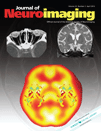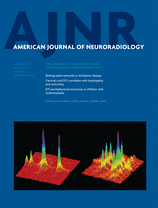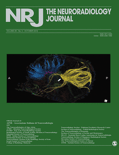
JOURNAL OF NEUROIMAGING
Scope & Guideline
Advancing the Frontiers of Neuroimaging Knowledge
Introduction
Aims and Scopes
- Clinical Neuroimaging Applications:
The journal emphasizes the use of neuroimaging techniques in clinical settings, particularly in diagnosing and managing neurological disorders such as stroke, epilepsy, and multiple sclerosis. - Advanced Imaging Techniques:
Research on innovative imaging modalities, including MRI, PET, and CT, is a core focus, highlighting advancements that enhance diagnostic accuracy and therapeutic monitoring. - Machine Learning and AI in Neuroimaging:
There is a growing interest in the application of artificial intelligence and machine learning techniques to improve neuroimaging analysis and interpretation, reflecting a modern trend in the field. - Functional and Structural Imaging:
The journal covers studies that investigate both functional and structural aspects of the brain, contributing to a holistic understanding of neurological conditions. - Neuroimaging Biomarkers:
Research related to identifying imaging biomarkers for various neurological diseases is prominent, aiding in the development of predictive models and personalized medicine.
Trending and Emerging
- Integration of Multimodal Imaging:
There is an increasing trend towards studies that utilize multiple imaging modalities simultaneously, providing a more comprehensive view of brain function and pathology. - Neuroimaging in Neurodegenerative Disorders:
Research focusing on the role of neuroimaging in understanding and managing neurodegenerative diseases, particularly Alzheimer's and Parkinson's, is becoming more prominent. - Artificial Intelligence and Image Analysis:
The application of AI and machine learning techniques for analyzing neuroimaging data is rapidly growing, indicating a shift towards computational approaches in imaging research. - Personalized Medicine Approaches:
Studies that explore how neuroimaging can inform personalized treatment strategies for neurological conditions are emerging, aligning with broader trends in precision medicine. - Functional Connectivity Studies:
Research on functional connectivity using advanced imaging techniques, particularly fMRI, is trending, helping to elucidate brain network dynamics in health and disease.
Declining or Waning
- Traditional Imaging Techniques:
There appears to be a waning interest in conventional imaging methods like standard CT and MRI without advanced techniques, as the field moves towards more sophisticated imaging modalities. - General Reviews without Novel Insights:
The journal has seen a decline in purely review articles that do not present new data or insights, as the focus shifts towards original research and innovative findings. - Single-Modal Imaging Studies:
There is less emphasis on studies that rely solely on one imaging modality, as the trend moves towards multimodal approaches that combine various techniques for comprehensive analysis.
Similar Journals

Neurology International
Exploring the Frontiers of Neurological ScienceNeurology International is a prestigious open-access journal published by MDPI that has been making significant contributions to the field of neurology since its establishment in 2009. With its ISSN 2035-8377, this journal is committed to disseminating high-quality, peer-reviewed research that addresses a wide range of clinical topics in neurology. Operating out of Basel, Switzerland, the journal holds a respectable Q2 ranking in the clinical neurology category as of 2023, indicating its influence and dedication to advancing scientific knowledge. Researchers and practitioners alike will find value in its comprehensive articles, which are readily accessible to a global audience, facilitating the sharing of innovative findings and clinical practices. As it converges towards 2024, Neurology International continues to provide a vital platform for scholarly discourse, aiming to improve patient outcomes and enhance our understanding of neurological disorders.

Neurophotonics
Pioneering the Fusion of Neuroscience and PhotonicsNeurophotonics is a leading Open Access journal published by SPIE-SOC PHOTO-OPTICAL INSTRUMENTATION ENGINEERS, focusing on the intersection of neuroscience and photonics. Launched in 2014, this journal has rapidly ascended to achieve Q1 rankings in several categories, including Neuroscience (miscellaneous), Radiological and Ultrasound Technology, and Radiology, Nuclear Medicine and Imaging, showcasing its significant impact within these fields. With an impressive Scopus ranking of #6 in Neuroscience and #12 in Radiological and Ultrasound Technology, Neurophotonics provides a vital forum for researchers, professionals, and students dedicated to advances in optical imaging and monitoring techniques for brain research and related applications. The journal is committed to disseminating high-quality research, insights, and innovations that drive forward the understanding of neural mechanisms through light-based techniques. Accessible since 2019, it promotes wider dissemination of knowledge, making it a crucial resource for those exploring the dynamic interplay between neuroscience and optical technologies.

AMERICAN JOURNAL OF NEURORADIOLOGY
Elevating Standards in Neurological Imaging and CareAMERICAN JOURNAL OF NEURORADIOLOGY, published by the American Society of Neuroradiology, is a premier peer-reviewed journal dedicated to advancing the field of neuroradiology. With an ISSN of 0195-6108 and an E-ISSN of 1936-959X, the journal serves as a vital resource for clinicians, researchers, and students in the realms of neurology and radiology. With a commendable Q1 ranking in multiple categories including Medicine (Miscellaneous), Clinical Neurology, and Radiology, Nuclear Medicine and Imaging, it remains at the forefront of scholarly communication since its inception in 1980. The journal enjoys significant visibility, ranked #47 out of 333 in radiology and #81 out of 400 in clinical neurology, highlighting its impact within these competitive fields. Although it is not open access, AMERICAN JOURNAL OF NEURORADIOLOGY is committed to publishing innovative research that enhances clinical practice and informs neurological imaging techniques, making it an essential read for anyone involved in the advanced study of neuroradiology.

Biological Psychiatry
Elevating the dialogue on mental health through innovative biological research.Biological Psychiatry is a premier journal dedicated to advancing the understanding of the biological underpinnings of psychiatric disorders. Published by Elsevier Science Inc, this esteemed journal is recognized globally for its rigorous peer-reviewed research and contributes significantly to the field of biological psychiatry. With an impressive impact factor that places it in Q1 of its category and ranks 3rd out of 51 in Neuroscience Biological Psychiatry, it reflects the journal's strength in disseminating high-quality findings that push the boundaries of knowledge. Since its inception in 1969, the journal has undergone continuous evolution, aiming to integrate biological and clinical perspectives to optimize the understanding of mental health conditions. Although it does not offer open access, Biological Psychiatry serves as a critical resource for researchers, practitioners, and students, offering insights that influence both theoretical frameworks and practical applications in the realm of psychiatric science.

Neuroradiology Journal
Advancing the frontiers of neuroradiological science.Neuroradiology Journal is a prominent publication in the fields of medicine, neurology, and radiology, published by SAGE PUBLICATIONS INC. Located in Italy, this journal has been a key resource since its inception in 2006 and continues to showcase vital research up to 2024. With an ISSN of 1971-4009 and an E-ISSN of 2385-1996, it provides an open platform for groundbreaking studies, effectively bridging clinical practices and advancements in imaging techniques. Holding a respectable position in Q3 of the 2023 category rankings for medicine, neurology, and radiology, the journal caters to a diverse audience of researchers, professionals, and students, driving innovations in neuroradiology and influencing best practices worldwide. Although not an open-access journal, it remains accessible through various subscription options, ensuring that significant findings are distributed widely within the medical community. Stay informed on the latest research and trends that continue to shape the landscape of neuroradiological science through Neuroradiology Journal.

NEUROPEDIATRICS
Fostering breakthroughs in the understanding of pediatric neurology.NEUROPEDIATRICS is a prominent academic journal published by GEORG THIEME VERLAG KG, dedicated to advancing the understanding and treatment of neurological disorders in children. Established in 1980, this journal has consistently provided a platform for innovative research and clinical practice in the fields of pediatrics and neurology, culminating in its recognition across various rankings; it holds a Q2 rating in Pediatrics, Perinatology and Child Health, and Q3 in both Medicine (miscellaneous) and Neurology (clinical) as of 2023. While NEUROPEDIATRICS is not an open access journal, it remains a crucial resource for researchers, clinicians, and students who seek cutting-edge insights and evidence-based practices in the management of pediatric neurological issues. As a result, NEUROPEDIATRICS plays an indispensable role in shaping future research directions and improving health outcomes in this vital field.

RADIOLOGY
Exploring new horizons in diagnostic imaging.RADIOLOGY, published by the Radiological Society of North America (RSNA), stands as a premier journal in the fields of radiology, nuclear medicine, and imaging. Established in 1945, this esteemed journal has consistently provided groundbreaking research and insights, helping to shape advancements in diagnostic imaging and therapeutic interventions. With a commendable Q1 ranking in its category and a remarkable 99th percentile ranking in Scopus, RADIOLOGY continues to be a pivotal resource for clinicians, researchers, and students alike. Although not an Open Access journal, it offers a wealth of high-quality peer-reviewed articles that contribute significantly to the ongoing discourse in the medical community. With a strong focus on innovative techniques and the integration of new technologies, RADIOLOGY remains essential for professionals aiming to stay at the forefront of medical imaging practices.

PSYCHIATRY RESEARCH-NEUROIMAGING
Exploring the Complexities of Brain and BehaviorPSYCHIATRY RESEARCH-NEUROIMAGING, published by Elsevier Ireland Ltd, stands at the intersection of neuroscience, psychiatry, and medical imaging, specializing in the latest advancements in neuroimaging techniques and their applications in psychiatric research. With a robust history since 1990, this esteemed journal features original research, reviews, and case studies that contribute significantly to the understanding of brain function in mental health disorders. Holding a notable Impact Factor and classified in Q2 for the fields of Neuroscience and Psychiatry and Q1 for Radiology, it serves as a vital resource for scholars and practitioners seeking to advance their knowledge in these domains. The journal is indexed in major databases, enhancing visibility and accessibility for global researchers. While it currently does not follow an open-access model, its reputable standing in Scopus ranks, alongside its targeted scope, makes it indispensable for those invested in neuroimaging research and its implications in psychiatry.

Neurosciences
Exploring the complexities of the human brain and behavior.Neurosciences is a premier academic journal dedicated to the exploration of neurological and psychiatric disorders, fostering an innovative exchange of ideas and research findings in these critical fields. Published by the Riyadh Armed Forces Hospital in Saudi Arabia, this interdisciplinary journal has consistently contributed to the advancement of knowledge since its inception in 2002 and is set to continue through 2024. With an ISSN of 1319-6138 and E-ISSN of 1658-3183, it is recognized for its emphasis on clinically relevant research in neurology and psychiatry, boasting a 2023 classification in the Q3 tier of both categories. Neurosciences encourages submissions that offer novel insights into mental health and neurological conditions, positioning itself as a vital resource for researchers, healthcare professionals, and students alike. Despite being unlisted as an open-access journal, it remains a respected outlet for peer-reviewed content, with Scopus rankings that highlight its growing influence within the scientific community. This journal serves as an essential platform for disseminating significant research that addresses the intricacies of the human brain and behavior.

Brain Communications
Fostering Knowledge in Neuroscience and PsychiatryBrain Communications is an esteemed, open-access academic journal published by Oxford University Press since 2019, focusing on the dynamic field of neuroscience. With a dedicated ISSN and an E-ISSN of 2632-1297, this journal aims to address the intricate relationships between brain functions, psychiatric disorders, and neurobiological mechanisms. The journal stands out in the academic realm, holding a prestigious Q1 ranking across several categories, including Biological Psychiatry, Cellular and Molecular Neuroscience, Neurology, and Psychiatry and Mental Health for 2023. Notably, it has also secured impressive Scopus ranks in various neuroscience and psychiatry fields, evidencing its commitment to high-quality research. With an impact factor reflective of its growing influence, Brain Communications provides accessible research findings to professionals, researchers, and students alike, fostering a deeper understanding of complex neurological phenomena. This innovative journal is pivotal for anyone involved in advancing knowledge in neuroscience and mental health.